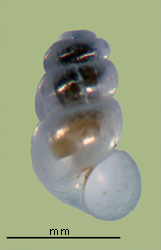> Habitat & Distribution
The range of this minute hydrobiid was given by Hershler and colleagues (1990) as Found in caves in Ohio River drainages of eastern West Virginia, from the Monongahela River south to the New River Basin. The USNM does contain two more recent records from Virginia caves, however, a 1994 record from Highland County and a 1995 record from Bath. This extends the range of F. tartarea into the upper James River basin, and waters flowing eastward toward the Atlantic.
A broad-brush review of the zoogeography of North American cavesnails has been offered by Hershler & Holsinger (1990). See the paper by Gladstone and collegues (2021) for a review of Fontigens distribution generally. FWGNA incidence unranked.
> Ecology & Life History
Fontigens tartarea is apparently a stygobiont, obligately adapted to the cave environment. The waters of limestone caves are (of course) rich in minerals, but poor in organics. Presumably the entire ecosystem of F. tartarea is based on fine organic matter raining down from the lighted world above.
Populations (of all Fontigens species) typically seem to maintain constant densities year round, as though reproduction might be continuous. This would certainly seem a reasonable assumption for F. tartarea, living nearly divorced from seasonal cues. Weck (2022) reported approximately one year to maturity (3 mm) in laboratory populations of the cave-dwelling Fontigens antroecetes, constant low levels of reproduction (25 - 80 eggs/pair/yr), and a lengthy hatch time of 70 - 80 days.
> Taxonomy & Systematics
Fontigens tartarea is a member of the "orolibas group" characterized by a tripartite penis with a tubular distal lobe and a bulbous proximal lobe. The animal is unpigmented and unusually small, even by hydrobioid standards, no more than 2.3 mm maximum shell length. The multivariate study of Gladstone et al. (2021) confirmed that the shell morphology of F. tartarea is distinct from most of the other recognized species studied, although not from F. orolibas, widespread further east.
The mtDNA sequence study of Liu and colleagues (2021), across 13 populations of 9 Fontigens species, included 2 individuals sampled from a population of F. tartarea in Greenbrier County, WV. See my essay of 9Aug22 from the link below for a review.
Taylor (1966) suggested that Fontigens comprises a distinct hydrobiid subfamily, the Fontigentinae, which Hershler et al. (1990) synonymized under the Emmericiinae of Brusina (1870). Wilke et al. (2013) did not confirm a close association between Fontigens (represented by a single sample) and the European genus Emmericia, however, tentatively returning the Fontigentinae to subfamilial status. Despite this evidence, self-appointed experts insisted on placing Fontigens in the Emmericiidae for several years (Bouchet et al. 2017), until Gladstone & Whelan (2022) split the genus to its own separate family, the Fontigentidae.
> Maps and Supplementary Resources
> Essays
- I wrote an essay on 22Aug07 about a hunt for the troglobitic hydrobiid Holsingeria unthanksensis in southwest Virginia, offering some observations likely relevant to the biology of Fontigens tartarea as well. See Cave Snail Adventure.
- Earlier versions of this website, online until August of 2016, adopted the large, broadly-inclusive concept of the Hydrobiidae (sl) following Kabat & Hershler (1993). More recently the FWGNA project has shifted to the Wilke et al. (2013) classification system, distinguishing a much smaller Hydrobiidae (ss) and elevating many hydrobioid taxa previously ranked as subfamilies to the full family level. For more details, see The Classification of the Hydrobioids.
- See my essay of 9Aug22, Startled by Fontigens, sort-of, I suppose for a review of the paper by Liu et al. (2021) documenting unusually high levels of intraspecific mtDNA sequence divergence.
> References
Bouchet, P., J. Rocroi, B.
Hausdorf, A. Kaim, Y. Kano, A. Nutzel, P. Parkhaev, M. Schrodl, and E.
Strong (2017) Revised classification, nomenclator and
typification of gastropod and monoplacophoran families. Malacologia,
61: 1 526.
Gladstone, N.S., E.
Pieper, S. Keenan, A. Paterson, M. Slay, K. Dooley, A. Engel, and M.
Niemiller (2021)
Discovery of the Blue Ridge springsnail, Fontigens orolibas
Hubricht 1957 (Gastropoda: Emmericiidae) in East Tennessee and its
conservation implications. Freshwater Mollusk Biology and
Conservation 24: 34 - 42.
Gladstone, N. S. and N.
Whelan (2022) Pushing barcodes to their limits:
phylogenetic placeament of Fontigens
Pilsbry, 1933 (Caenogasatropoda: Littorinimorpha: Truncatelloidea) and
elevation of Fontigentidae Taylor, 1966. Journal of Molluscan
Studies 88: eyab038.
Hershler, R. H. &
J. R. Holsinger (1990) Zoogeography of North
American hydrobiid cavesnails. Stygologia 5: 5-16.
Hershler, R., J.R. Holsinger & L. Hubricht (1990)
A revision of the North American freshwater snail genus Fontigens
(Prosobranchia: Hydrobiidae). Smithsonian Contributions to
Zoology 509:1-49.
Hubricht, L.
(1963) New species of Hydrobiidae.
Nautilus 76: 138-140.
Kabat, A.R., and R.
Hershler (1993)
The prosobranch snail family Hydrobiidae (Gastropoda: Rissooidea):
review of classification and supraspecific taxa. Smithsonian
Contributions to Zoology 547:1-94.
Liu, H-P., L. Schroeder, A.
Berry, and R. T. Dillon, Jr. (2021) High levels
of mitochondrial DNA sequence divergence among isolated populations of Fontigens
(Truncatelloidea: Emmericiidae) in eastern USA. Journal of
Molluscan Studies 87: eyab026. [pdf]
Taylor, D.W. (1966) Summary
of North American Blancan nonmarine molluscs. Malacologia
4: 1 - 172.
Weck, R.G. (2022)
Life history observations of the Illinois state
endangered Enigmatic Cavesnail, Fontigens
antroecetes (Hubricht, 1940) made under simulated cave
conditions. Subterranean Biology 43: 185 - 198.
Wilke T., Haase M.,
Hershler R., Liu H-P., Misof
B., Ponder W. (2013)
Pushing short DNA
fragments to the limit: Phylogenetic relationships of hydrobioid
gastropods
(Caenogastropoda: Rissooidea). Molecular
Phylogenetics and Evolution 66: 715 736.








